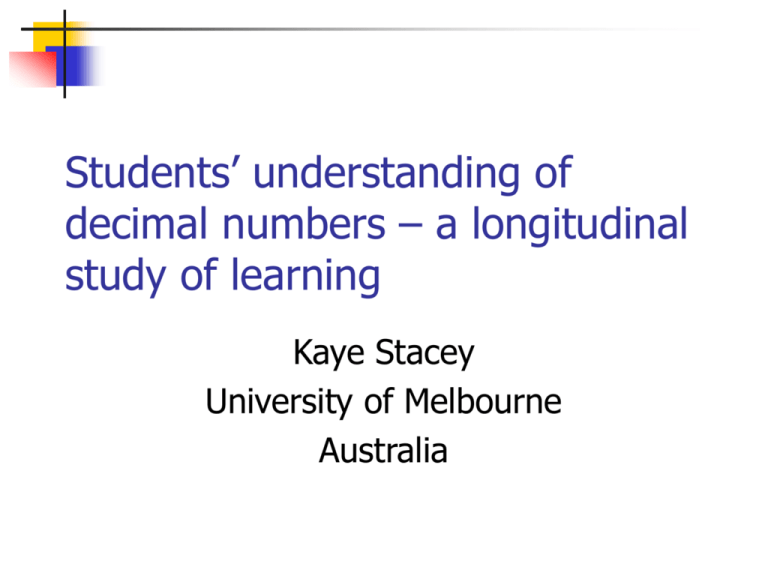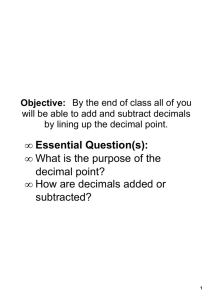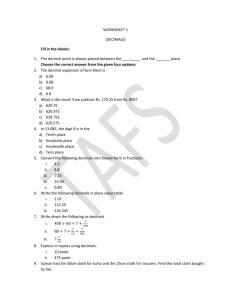shorter-is
advertisement

Students’ understanding of decimal numbers – a longitudinal study of learning Kaye Stacey University of Melbourne Australia Our decimals work - a summary Understanding how students think about decimals Tracing students’ progress in the longitudinal study Teaching interventions CD and website for teachers Thanks to Vicki Steinle Liz Sonenberg Ann Nicholson Tali Boneh Sue Helme Nick Scott Australian Research Council many U of M honours students Dianne Chambers teachers and children providing data Why decimals? Practical Importance Common use in everyday life e.g. economic measures Links to metric measuring Is a statistics p value over 0.05? Fundamental role of number in mathematics (e.g. understanding 0) Known to be complex with poor learning A case study of students’ growth of understanding, which was able to start from a good research base Understanding decimal notation Why is such a simple rule as rounding hard to remember? 27.483 3.145 Similar items – different success Select the largest number from 0.625, 0.5, 0.375, 0.25, 0.125 Correct: 61% Select the smallest number from 0.625, 0.5, 0.375, 0.25, 0.125 Correct: 37% et al Why such a large difference? Foxman (1985) Results of All sets given here as largest to smallest; not as presented. large scale “APU” monitoring UK. Common patterns in answers 0.625 0.5 0.375 0.25 0.125 Largest Smallest 0.625 0.125 correct (A) 0.625 0.5 well known error “longer-is-larger” (L) 0.5 0.625 identified 1980s “shorter-islarger” (S) Persistent patterns Select the smallest number from 0.625, 0.5, 0.375, 0.25, 0.125 Option TIMMS-R International TIMMS-R Australia 0.125 46% 58% 0.25 4% 4% 0.375 2% 1% 0.5 24% 15% 0.625 24% 22% Grade 8 – 13 year olds Longitudinal data from: 3204 students 9862 short tests tests averaged 8.3 months apart individuals completed from 1 – 7 tests over 3.5 years Grades 4 – 10 Grades 0 – 6 (ages 5 – 12) “primary” Grades 7 – 12 (ages 12 – 18) “secondary” 12 volunteer schools, known to be “typical” No special teaching for this sample Sample data Maximum 2 tests per year Every test result is a code that signifies students’ interpretation of decimals ID 210403026 300704112 310401041 390704012 400704005 410401088 500703003 500703030 600703029 Grade 4 L1 Grade 5 A1 L2 L1 L1 L1 Grade 6 S3 S5 U1 L4 U1 L1 Grade 7 S1 L1 L4 L4 U1 L1 A1 A1 A2 L2 A1 S1 S3 A1 Grade 8 Grade 9 L4 U1 U1 A1 A1 S5 S5 L2 L1 A1 A2 S3 A1 U1 S3 S1 A1 S3 A2 A1 Grade 10 U1 A3 Decimal Comparison Test (DCT2) We now have better version Decimal Comparison Test (DCT2) We now have better version Set of very similar items set of very similar items Complex test, easy to complete Several items of each type Codes require consistent responses Items within types VERY carefully matched Comparison Item A1 A2 L1 L2 S1 S3 U2 4.8 4.63 5.736 5.62 4.7 4.08 4.4502 4.45 0.4 0.3 S behaviour: “shorter-is-larger” 5.736 < 5.62 (because 736 larger than 62; like fractions or negative numbers) 5.736 < 5.62 (62 is “tenths” and 736 is “only thousandths”) Several reasons for each group of behaviours S behaviour: false number line analogies with place value Th H T U t h th -3 -2 -1 0 1 2 3 Further right means smaller 5.736 “further right” than 5.62 0. 6 < 0 because 0 is in “units column” Where are the students in each grade? Prevalence of coarse codes by grade 100% 90% 80% 70% A 60% U 50% S 40% L 30% 20% 10% 0% Gr 4 Gr 5 Gr 6 Gr 7 Gr 8 Gr 9 Gr 10 Prevalence of A codes by grade 25% expert at Grade 5, 50% in next 4 years, 25% never Important in adult education e.g. nurses “death by decimal” We know our test overestimates expertise! A1 = expert 90% 80% 70% 60% A3 50% A2 40% A1 30% 20% 10% 0% Gr4 Gr5 Gr6 Comparison Item Gr7 Gr8 Gr9 A1 A2 A3 4.8 4.63 5.736 5.62 4.7 4.08 - 4.4502 4.45 - 0.4 0.3 - Gr10 Prevalence of A codes by grade 90% A1 = expert 80% 70% 60% A3 50% A2 40% A1 30% 20% 10% 0% Gr4 Gr5 Gr6 Gr7 Gr8 Gr9 Gr10 Note: 10% in the non-expert A category These students mostly think that 4.4502 < 4.45 etc - can usually deal well with decimals to 2 places Prevalence of L codes L drops exponentially (L = 440exp(-0.45*grade)) L2 about 5% in Grades 5-8: some just accumulating facts, not changing concepts 80% 70% 60% 50% L4 40% L2 L1 30% 20% 10% 0% Gr4 Gr5 Gr6 Gr7 Gr8 Gr9 Gr10 Prevalence of S codes 25% 20% 15% •Always about 15% •Maximum in Grade 8 due to learning negative numbers and indices S5 S3 S1 10% 1 103 1000 5% 0% Gr4 Gr5 Gr6 Gr7 Gr8 Gr9 Gr10 25% Thinking in S 20% 15% S5 S3 S1 10% Around 5% in S1 in all grades 5% 0% Gr4 Gr5 Gr6 Gr7 Gr8 0.6 < 0.7 0.5 <0.125 x Immature place value thinking ( e.g. “hundredths smaller than tenths”) Gr9 Gr10 Around 10% in S3 in all grades (more Grade 8) 0.6 < 0.7 x 0.5 <0.125 x analogy with fractions (one sixth, one seventh) analogy with negative numbers (-6, -7) do not think about place value at all Another look at prevalence How many students have each thinking at some stage? Student-focussed prevalence Student-focussed prevalence of codes amongst primary (left side) and secondary (right side) students 90% 80% 70% 60% 50% 40% 30% 20% 10% 0% A1 L S A2, A3 U2 A1 L S A2, A3 At some stage during Grades 7 – 10: 80% of students are expert (A1) 20% - 30% are in each of the non-expert codes U2 Different prevalence for younger students Persistence Where do students stay the longest? Answer: A1 (expert) - good! Probability of getting the same test result after 1, 2, 3, 4 tests About 35% of L,S,U retest same after one 50% semester 40% About 15% retest same 30% after 2.5 years Schooling is often not 20% impacting on ideas! 10% Our teaching 0% experiments show a little targetted teaching works! 8 months 16 months L 24 months S 32 months Which students are most likely to become expert on the next test? Answer: (i) non-expert A (but we think this is false result – they may have little understanding) (ii) unclassified – it is better not to have a definite misconception – more open to new ideas? Lessons about learning Different misconceptions have different causes and are impacted differently by the learning environment L1 - naïve, first guess without teaching, decreases in prevalence S – supported by features in the curriculum, operating at deep psychological level, so reinforced especially in secondary school Need to learn principles, not accumulate facts Contrast between orientation to learning principles vs accumulating facts expert: a few math’l principles requiring mastery of a web of complex relations between them For some students and teachers: a large number of facts to learn with weak links between them Important not to teach isolated facts Thank you Teaching and Learning About Decimals Website http://extranet.edfac.unimelb.edu.au/DSME/decimals







